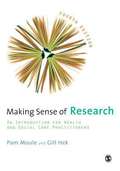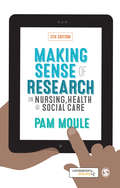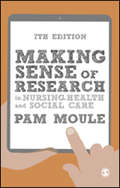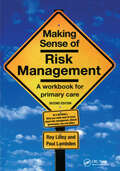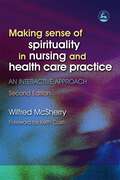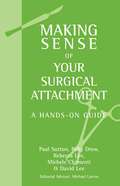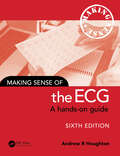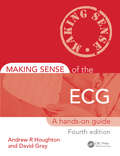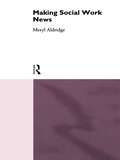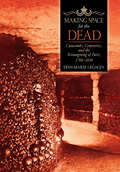- Table View
- List View
Making Sense of Research
by Pam MouleTo help health and social care professionals develop research literacy, this introductory text overviews the relevant elements of evidence-based practice from key terms and concepts to research dissemination and implementation. The text includes highlighted key points, further reading, appended material on conducting literature searches and appraising a study, and a glossary. The references include a listing for each of the authors; that of Moule is her doctoral thesis at the U. of the West of England, Bristol. Hek's professional affiliation is not given. A Web search shows the dates of previous editions to be 2002 and 1996. Annotation ©2006 Book News, Inc. , Portland, OR (booknews. com)
Making Sense of Research in Nursing, Health and Social Care
by Pam MouleWhat is research? Why is it important in health and nursing? How should students use evidence in practice? This short and simple book for those who are completely new to research will answer all your students' questions about the subject. It will help them to make sense of the various and often confusing research methods and terminology, to read and appraise literature and to understand how research is implemented in practice. It features: · Case examples of real research from a variety of settings and a range of countries so that students can see how research applies to the real world · Tools, examples and frameworks to help students to find, appraise and critique research · Chapter learning outcomes and key points to help students to remember important information · A companion website with interactive glossary and reflective exercises to help students test their knowledge and apply it to practice, printable step-by-step frameworks for use when searching for or critiquing a paper, and direct links to relevant SAGE journal articles and weblinks. · Further resources for lecturers are available, including all the practice examples from the book, seminar question ideas and critical appraisal powerpoints. The book is essential reading for undergraduate and postgraduate students of nursing and health in the UK and internationally.
Making Sense of Research in Nursing, Health and Social Care
by Pam MouleWhat is research and how does it work in the context of nursing, health and social care? This introductory guide provides you with a concise overview of the different research methods and terminology that you will come across when undertaking research in any course related to nursing, health and social care. The book′s easy-to-follow structure takes you from research novice to confident researcher, helping you to make sense of research and understand how it is implemented in healthcare practice. The new edition includes: Updates in light of the 2018 NMC standards, with more information on the impact of GDPR, consent and vulnerable groups, Personal and Public Involvement (PPI), and work-based projects. Improved case examples of real research, with more on group work, poster presentations, research output and dissemination, literature reviews, and dissertations. Upgraded activities that include reflective exercises, critical appraisal tools, a dissemination plan, and a glossary, all in the book. This is essential reading for undergraduate and postgraduate students within the health and therapy professions, nurses, midwives, physiotherapists, radiographers, occupational therapists, speech and language therapists, and paramedics.
Making Sense of Research in Nursing, Health and Social Care
by Pam MouleWhat is research and how does it work in the context of nursing, health and social care? This introductory guide provides you with a concise overview of the different research methods and terminology that you will come across when undertaking research in any course related to nursing, health and social care. The book′s easy-to-follow structure takes you from research novice to confident researcher, helping you to make sense of research and understand how it is implemented in healthcare practice. The new edition includes: Updates in light of the 2018 NMC standards, with more information on the impact of GDPR, consent and vulnerable groups, Personal and Public Involvement (PPI), and work-based projects. Improved case examples of real research, with more on group work, poster presentations, research output and dissemination, literature reviews, and dissertations. Upgraded activities that include reflective exercises, critical appraisal tools, a dissemination plan, and a glossary, all in the book. This is essential reading for undergraduate and postgraduate students within the health and therapy professions, nurses, midwives, physiotherapists, radiographers, occupational therapists, speech and language therapists, and paramedics.
Making Sense of Research in Nursing, Health and Social Care
by Pam MouleWhat is research and how does it work in the context of nursing, health and social care? This introductory guide provides you with a concise overview of the different research methods and terminology that you will come across when undertaking research in any course related to nursing, health and social care. The book′s easy-to-follow structure takes you from research novice to confident researcher, helping you to make sense of research and understand how it is implemented in healthcare practice. The new edition includes: Updates in light of the 2018 NMC standards, with more information on the impact of GDPR, consent and vulnerable groups, Personal and Public Involvement (PPI), and work-based projects. Improved case examples of real research, with more on group work, poster presentations, research output and dissemination, literature reviews, and dissertations. Upgraded activities that include reflective exercises, critical appraisal tools, a dissemination plan, and a glossary, all in the book. This is essential reading for undergraduate and postgraduate students within the health and therapy professions, nurses, midwives, physiotherapists, radiographers, occupational therapists, speech and language therapists, and paramedics.
Making Sense of Research in Nursing, Health and Social Care
by Professor Pam MouleWhat is research? Why is it important in health and nursing? How should students use evidence in practice? This short and simple book for those who are completely new to research will answer all your students’ questions about the subject. It will help them to make sense of the various and often confusing research methods and terminology, to read and appraise literature and to understand how research is implemented in practice. It features: · Case examples of real research from a variety of settings and a range of countries so that students can see how research applies to the real world · Tools, examples and frameworks to help students to find, appraise and critique research · Chapter learning outcomes and key points to help students to remember important information · A companion website with interactive glossary and reflective exercises to help students test their knowledge and apply it to practice, printable step-by-step frameworks for use when searching for or critiquing a paper, and direct links to relevant SAGE journal articles and weblinks. · Further resources for lecturers are available, including all the practice examples from the book, seminar question ideas and critical appraisal powerpoints. The book is essential reading for undergraduate and postgraduate students of nursing and health in the UK and internationally.
Making Sense of Research in Nursing, Health and Social Care
by Professor Pam MouleWhat is research and how does it work in the context of nursing, health and social care? Now in its 6th edition, this easy to read guide keeps on providing a concise overview of the different research methods and terminology and helps readers understand how research is implemented in practice. The new edition includes: o Case examples of real research from a variety of settings and countries o Updates in light of the new NMC standards, more on critical appraisal tools and service improvement o Chapter learning outcomes and key points o A companion website featuring an interactive glossary, reflective exercises and free access to SAGE journal articles for students, as well as SAGE videos and seminar notes for lecturers and more This is essential reading for undergraduate and postgraduate students of nursing and health in the UK and internationally.
Making Sense of Research in Nursing, Health and Social Care
by Professor Pam MouleWhat is research and how does it work in the context of nursing, health and social care? Now in its 6th edition, this easy to read guide keeps on providing a concise overview of the different research methods and terminology and helps readers understand how research is implemented in practice. The new edition includes: o Case examples of real research from a variety of settings and countries o Updates in light of the new NMC standards, more on critical appraisal tools and service improvement o Chapter learning outcomes and key points o A companion website featuring an interactive glossary, reflective exercises and free access to SAGE journal articles for students, as well as SAGE videos and seminar notes for lecturers and more This is essential reading for undergraduate and postgraduate students of nursing and health in the UK and internationally.
Making Sense of Risk Management: A Workbook for Primary Care, Second Edition
by Roy Lilley Paul LambdenWhat you really need to know about risk management, clinical governance, law and ethics… Now completely revised and updated Making Sense of Risk Management: a workbook for primary care breaks down complex issues and presents them in an easily comprehensible manner. Addressing current issues such as the new GP Contract and the rapid rise in litigation, this new edition takes on a more rigorous approach but maintains the same light-hearted style with more detailed and definitive guidance. The format makes use of tips, warnings, tables, exercises and think boxes providing an informative, interesting and engaging read. All primary care staff including General Practitioners, managers, nurses, health visitors, administrative staff and receptionists will find this book invaluable.
Making Sense of Self-harm: The Cultural Meaning And Social Context Of Non-suicidal Self-injury
by Peter SteggalsMaking Sense of Self-Harm provides an alternative approach to understanding nonsuicidal self-injury; using Cultural Sociology to analyse it more as a practice than an illness and exploring it as a powerful cultural idiom of personal distress and social estrangement that is peculiarly resonant with the symbolic life of late-modern society.
Making Sense of Sleep Medicine: A Hands-On Guide (Making Sense of)
by Karuna Datta Deepak ShrivastavaThis is a practical and patient-complaint focused handbook, directed to motivate non-sleep experts and beginners in sleep medicine and technology. This book provides a basic review of the area of sleep, identifies some common patient presentations and illustrates the types of investigations that should be requested. With sleep and breathing problems being so common and affecting many other chronic clinical conditions, it is important that primary care and other general physicians as well as allied health practitioners have a greater appreciation of this area. This text is a valuable “go-to” handbook for the occasional “sleep” practitioner to refer to. Key Features:• Contains specially packaged with Specific Learning Objectives to each chapter followed by self-assessment questions, case scenarios, basic sleep monitoring techniques in detail with sample reports.• Provides direction to health care professionals who encounter patients with sleep and breathing disorders in their practice.• Uses algorithms and concept maps for dealing with specific symptoms.
Making Sense of Spirituality in Nursing and Health Care Practice: An Interactive Approach Second Edition
by Wilf Mcsherry'This is a well-written and useful book, particularly for those healthcare professionals who, with a little more confidence, and perhaps some Chaplaincy support, are well able to support their patients on their spiritual journeys. It would be an excellent tool for learning sessions between Chaplaincy and nursing staff, along with other relevant professional groups.' - Signpost 'This book considers why the spiritual needs of individuals are important. In an attempt to explain, the book uses case studies, which show the relationship of theory to practice. It is an interactive book encouraging reflection to explore the meaning of spirituality to patients and health care professionals. The exercises also attempt to explain the importance of a team approach to spiritual assessment as part of a holistic assessment. The book gives clear explanations of spirituality in the context of Holism and the different sections give plenty of food for thought. There are excellent references and suggestions for further reading. It is not a book for light reading but would be invaluable when encountering difficulties with a spiritual assessment or situation.' - Journal of Community Nursing Caring for the spiritual needs of patients is a highly significant yet often neglected and misunderstood aspect of health care. This results, in part, from a general lack of guidance and instruction given to healthcare professionals on the subject. This new edition of an established introductory guide to spirituality and health care practice draws extensively on case studies illustrating the application of theory to practice. It encourages the exploration, through reflective activities, of what spirituality means, both to patients and to the healthcare professionals caring for them. This book provides a comprehensive introduction to spiritual care for heath care professionals in all areas of practice.
Making Sense of Your Surgical Attachment: A Hands-On Guide
by David Lee Rebecca Lee Paul Sutton Polly Drew Michelle ChimentiYour surgical attachment is fast approaching and you have a number of questions that need answering to help you make the most of your experience... Making Sense of Your Surgical Attachment will answer them for you. Everything you need to know about the operating theatre and the use of surgical instruments is packed into this one handy guide:* The n
Making Sense of a Primary Care-Led Health Service
by Christina R. Victor Peter LittlejohnsThe shift of services from acute hospitals to general practice requires clinicians to become actively involved in the process of change. This book sets out to demonstrate that with careful planning, implementation and evaluation of this process, problems can be avoided and the quality of service enhanced. The authors demonstrate a clear understanding of the practical issues involved and their evident enthusiasm for the opportunities now available will stimulate innovation in hospital staff, the health care team in general practice and NHS managers responsible for the delivery of a more efficient and responsible service.
Making Sense of the Chest X-ray: A hands-on guide (Making Sense Of Ser.)
by Paul JenkinsWhen a patient presents to the emergency department, in the GP practice, or in the outpatient clinic with a range of clinical signs, the chest x-ray is one of the most valuable diagnostic tools available to the attending physician. Accurate interpretation and understanding of the chest x-ray is therefore a crucial skill that all medical students an
Making Sense of the ECG: A Hands-On Guide (Making Sense of)
by Andrew HoughtonInterpreting an ECG correctly and working out what to do next can seem like a daunting task to the non-specialist, yet it is a skill that will be invaluable to any doctor, nurse or paramedic when evaluating the condition of a patient. Making Sense of the ECG has been written specifically with this in mind, and will help the student and more experienced healthcare practitioner to identify and answer crucial questions. This popular, easy-to-read and easy-to-remember guide to the ECG as a tool for diagnosis and management has been fully updated in its fifth edition to reflect the latest guidelines.
Making Sense of the ECG: A Hands-On Guide (Making Sense of)
by Andrew HoughtonInterpreting an ECG correctly and working out what to do next can seem like a daunting task to the non-specialist, yet it is a skill that will be invaluable to any doctor, nurse or paramedic when evaluating the condition of a patient.Making Sense of the ECG has been written specifically with this in mind and, across multiple editions, has helped students and more experienced healthcare practitioners to identify and answer crucial questions, including:Are these abnormalities significant?How do I distinguish between VT and SVT?Does this patient have an acute coronary syndrome?How do I measure the QT interval?Should I refer this patient to a cardiologist?This popular, easy-to-read and easy-to-remember guide to the ECG as a tool for diagnosis and management has been fully updated in its sixth edition to reflect the latest guidelines, with new chapters added: ‘Reading an ECG Recording’ and 'Ten ECGs Not to Miss’.Key features: Real ECGs – with annotation throughout to highlight key features and new examples included Strong clinical emphasis – for rapid reference in the emergency department, ward or outpatient setting with increased focus on urgency of action required Enhanced summaries and improved tip boxes – for speedy access to key info and advice when to act quickly or seek help New to this edition – reading an ECG recording from first principles added, ten ECG abnormalities with the most serious clinical consequences if missed or misdiagnosed flagged, more detail on ‘normal’ heart rates, cardiac activation and conduction, optimal electrode placement, updated guidance on acute coronary syndromes and cardiopulmonary resuscitation and improved relevance for pre-hospital care Pair with Making Sense of the ECG: Cases for Self Assessment, Third Edition, for the complete ECG learning and revision package!
Making Sense of the ECG: A Hands-On Guide, Fourth Edition (Making Sense Of Ser.)
by David Gray Andrew HoughtonHighly Commended, BMA Medical Book Awards 2015Interpreting an ECG correctly and working out what to do next can seem like a daunting task to the non-specialist, yet it is a skill that will be invaluable to any doctor, nurse, or paramedic when evaluating the condition of a patient.Making Sense of the ECG has been written specifically with this in mi
Making Sense of the ECG: Cases for Self Assessment (Making Sense of)
by David Gray Andrew R. Houghton Andrew HoughtonMaking Sense of the ECG: Cases for Self-Assessment presents everything you need to assess your ability to interpret ECGs accurately, perform differential diagnosis, and decide upon the most appropriate clinical management in each situation. The patients' history, examination and initial investigations are presented along with questions on the ECG i
Making Sense of the ECG: Cases for Self Assessment (Making Sense of)
by Andrew R. HoughtonReading an ECG correctly and working out what to do next is an invaluable skill for any doctor, nurse or paramedic when evaluating the condition of a patient.Making Sense of the ECG: Cases for Self Assessment helps students and more experienced healthcare practitioners to consolidate their knowledge of ECG interpretation through real-life scenarios. The patients' history, examination and initial investigations are presented along with questions on the ECG interpretation, allowing readers to assess their ability to interpret ECGs accurately, perform differential diagnosis and decide upon the most appropriate clinical management in each situation. Detailed explanatory answers respond to the questions posed, as well as providing practical clinical guidance and essential revision support.Key features: Convenient format – ideal for both rapid reference and the presentation of full 12-lead ECG traces throughout Strong clinical emphasis – encourages you to put principles into practice Detailed explanations – aid in-depth learning Learn, revise and test yourself – use regularly to refresh your knowledge and ideal during exam preparation Used alongside the popular textbook Making Sense of the ECG: A Hands-on Guide 6E, or independently, as a vital tool to consolidate knowledge and prepare for clinical practice, this latest edition has been fully updated in line with the latest management guidelines and features a new appendix listing the key diagnosis in each ECG, making it easier to locate topics for revision.
Making Sense of the EEG: From Basic Principles to Clinical Applications (Making Sense of)
by Udaya SeneviratneThis book educates the reader on the cellular and neurophysical aspects of Electroencephalography (EEG), alongside its technical and engineering principles. Providing a background on normal EEG, the content includes the clinical applications of EEG in epilepsies and other brain disorders in order to provide the reader with the necessary knowledge to use EEG in clinical practice. Aimed at those who in the earlier stages of using EEGs, this resource provides an effective overview and offers a key resource to anyone using EEGs.
Making Sense of the Pediatric EEG (Making Sense of)
by Maria Augusta MontenegroMost neurologists, fellows, and residents are familiar with adult EEG, but have not developed a similar understanding of pediatric EEG. There are fewer resources covering pediatric electroencephalography and existing books are either too comprehensive or lack the main details that differentiate the EEG in childhood. This accessible text includes the most recent classification and nomenclature published by the International League Against Epilepsy. It provides a practical and well illustrated text of value to residents, fellows, and neurologists in need of an update on pediatric EEG.
Making Sense: Markets from Stories in New Breast Cancer Therapeutics (Culture and Economic Life)
by Sophie MützelBreast cancer is one of the most commonly diagnosed cancers and a leading cause of death for women worldwide. With advances in molecular engineering in the 1980s, hopes began to rise that a non-toxic and non-invasive treatment for breast cancer could be developed. These hopes were stoked by the researchers, biotech companies, and analysts who worked to make sense of the uncertainties during product development. In Making Sense Sophie Mützel traces this emergence of "innovative breast cancer therapeutics" from the late 1980s up to 2010, through the lens of the narratives of the involved actors. Combining theories of economic and cultural sociology, Mützel shows how stories are integral for the emergence of new markets; stories of the future create a market of expectations prior to any existing products; stories also help to create categories on what such a new market and its products are about. Making Sense uses thousands of press statements, media reports, scientific reports, and financial and industry analyses, and combines qualitative and large-scale computational text analyses, to illustrate these mechanisms, presenting a fresh view of how life-prolonging innovations can be turned into market products.
Making Social Work News
by Meryl AldridgeFirst published in 1994. Routledge is an imprint of Taylor & Francis, an informa company.
Making Space for the Dead: Catacombs, Cemeteries, and the Reimagining of Paris, 1780–1830
by Erin-Marie LegaceyThe dead of Paris, before the French Revolution, were most often consigned to mass graveyards that contemporaries described as terrible and terrifying, emitting "putrid miasmas" that were a threat to both health and dignity. In a book that is at once wonderfully macabre and exceptionally informative, Erin-Marie Legacey explores how a new burial culture emerged in Paris as a result of both revolutionary fervor and public health concerns, resulting in the construction of park-like cemeteries on the outskirts of the city and a vast underground ossuary. Making Space for the Dead describes how revolutionaries placed the dead at the center of their republican project of radical reinvention of French society and envisioned a future where graveyards would do more than safely contain human remains; they would serve to educate and inspire the living. Legacey unearths the unexpectedly lively process by which burial sites were reimagined, built, and used, focusing on three of the most important of these new spaces: the Paris Catacombs, Père Lachaise cemetery, and the short-lived Museum of French Monuments. By situating discussions of death and memory in the nation's broader cultural and political context, as well as highlighting how ordinary Parisians understood and experienced these sites, she shows how the treatment of the dead became central to the reconstruction of Parisian society after the Revolution.
